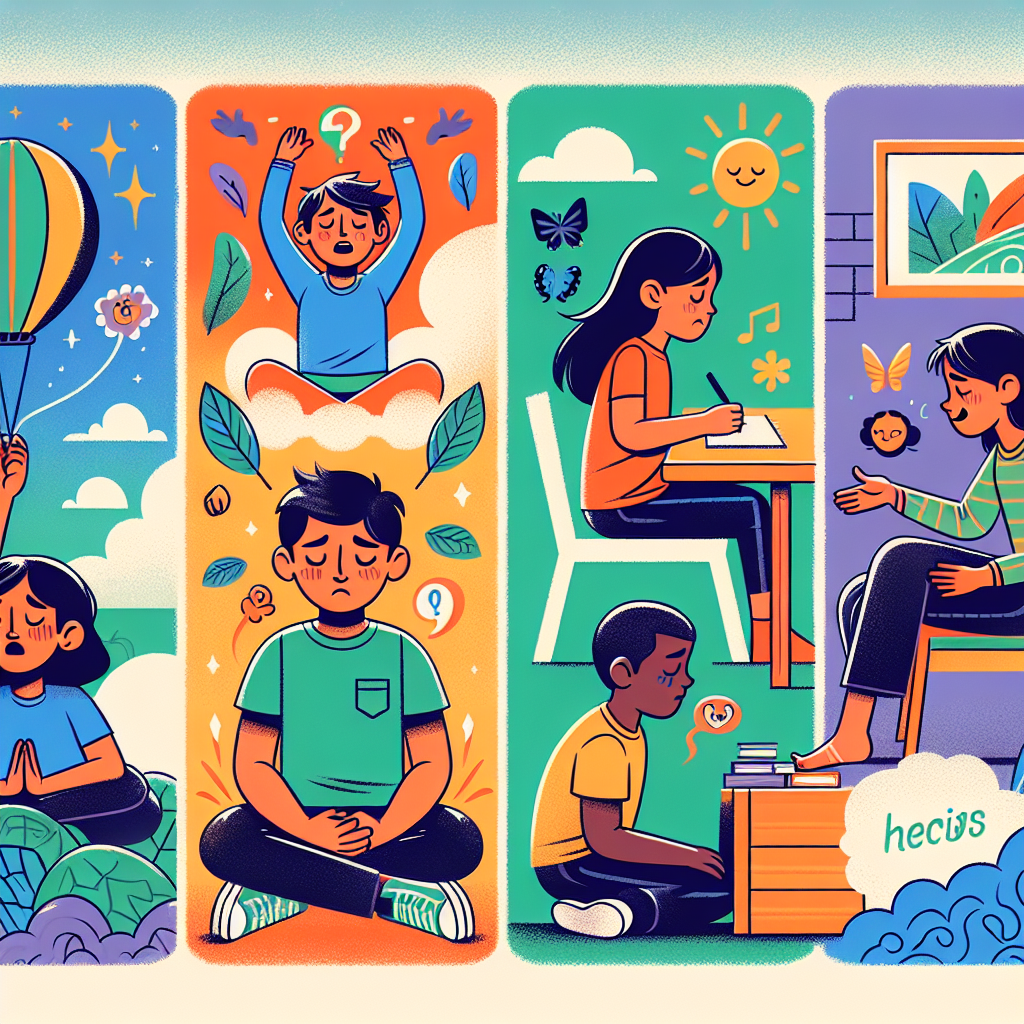As we navigate the intricate world of raising children, one common challenge that often surfaces is helping our little ones deal with worry and anxiety. In this blog post, we'll explore 5 Effective Ways to Help Children Deal with Worry, fostering resilience and emotional well-being.
1. Encourage Open Communication

A key foundation in aiding children with worry is establishing a safe space for open communication. Encourage your child to share their feelings and concerns without fear of judgment. By actively listening and validating their emotions, you create a supportive environment where they feel understood and comforted.
At times, children may find it challenging to pinpoint and articulate their emotions, leading them to convey their feelings through actions rather than words. For example, when a child experiences feelings of anxiety or worry, these emotions may manifest in physical symptoms such as stomach aches, nail-picking, or a reluctance to go to school.
If your child is unsure of how they feel, you can encourage them to explore their feelings through a variety of other ways:
Play
Drawing
Creative activities
Metaphors / storytelling
By using this indirect method, children are encouraged to express themselves, which promotes emotional growth and enhances communication between parents and children. A great deal can be learned from your child through these techniques.
2. Teach Relaxation Techniques

We often believe that when children have “excess energy,” the best solution is to let them run around to tire them out. However, this approach can actually make the situation worse by overstimulating them further. In reality, what they need in those moments is slow, mindful activities to help calm their overactive minds.
Science shows that when children engage in calming activities, it activates their parasympathetic nervous system, which is responsible for relaxation and reducing stress. This shift helps to lower cortisol levels and soothe their brains, leading to better emotional regulation and a more peaceful state of mind.
Teaching children relaxation techniques can equip them with valuable coping mechanisms.
Techniques like deep breathing, mindfulness exercises, or simple yoga poses can help alleviate stress and anxiety.
Introducing these techniques in a fun and engaging manner can make them more accessible and enjoyable for children.
The 5 Senses Game

A simple and effective mindfulness activity for a child is the “Five Senses Game.” This activity helps children focus on the present moment by engaging their senses. Here’s how it works:
1. Get Comfortable: Have the child sit or stand in a comfortable spot. Encourage them to take a few deep breaths to relax.
2. See: Ask the child to look around and name five things they can see. It could be anything in their surroundings, like a tree, a toy, or a picture on the wall.
3. Touch: Next, ask them to focus on four things they can feel. This could be the texture of their clothes, the smooth surface of a table, or the warmth of the sun on their skin.
4. Hear: Now, have the child listen carefully and identify three sounds they can hear. It might be the sound of birds chirping, the hum of a fan, or their own breathing.
5. Smell: Ask them to notice two things they can smell. If they’re indoors, it might be the scent of soap, food, or fresh air coming through a window.
6. Taste: Finally, ask the child to focus on one thing they can taste. If they’ve recently eaten, they might still taste food, or they can just notice the neutral taste in their mouth.
Wrap-Up
Once they’ve gone through all five senses, you can ask them how they feel or what they noticed during the activity. This simple game helps ground children in the present moment, reducing anxiety and increasing their awareness of their surroundings. It’s a fun and calming way to practice mindfulness with kids.
5 Finger Breathing (Starfish Breathing)
Mindful Coloring
Mindful Movement (Yoga Poses)
Calm Down Box (Worry Box)
3. Establish Routine and Predictability

Consistency and predictability can provide children with a sense of security and stability, which can be particularly comforting for anxious children.
Establishing routines for daily activities, bedtime, and meals creates a structured environment that helps reduce uncertainty and worry.
Healthy Bedtime Routine Example
Creating a calming bedtime routine without screens can help children wind down and prepare for a restful night’s sleep.
Here’s an example of a screen-free bedtime routine:
1. Wind-Down Time (30-45 minutes before bed)
• Dim the Lights: Lower the lighting in the house to signal that bedtime is approaching.
• Quiet Play: Encourage activities like puzzles, building blocks, or coloring. These activities are engaging but not overly stimulating.
• Tidy Up: Have the child help tidy up their toys. This signals the end of the day and creates a sense of order.
2. Bath or Wash-Up (20-30 minutes before bed)
• Warm Bath: A warm bath is soothing and helps lower the body’s temperature afterward, signaling that it’s time for sleep.
• Brush Teeth: After the bath, help them brush their teeth.
• Pajamas: Let them choose their pajamas to make them feel involved and comfortable.
3. Calm Down (10-20 minutes before bed)
• Gentle Stretching or Yoga: A few simple stretches or child-friendly yoga poses can help release any remaining tension from the day.
• Bedtime Story: Read a favorite book or a calming story. Choose stories that are relaxing rather than exciting.
• Storytelling or Soft Music: If your child enjoys it, you can also tell a story from memory or play soft, calming music in the background.
4. Bedtime Rituals (5-10 minutes before bed)
• Gratitude Practice: Ask your child to name one or two things they’re grateful for from the day. This creates a positive mindset before sleep.
• Hugs and Kisses: Share some cuddles, hugs, and kisses to offer comfort and connection.
• Say Goodnight: If your child has a favorite stuffed animal or blanket, make sure it’s with them. Say goodnight to the room, the house, and anything else that helps create a peaceful atmosphere.
5. Lights Out
• Night Light: If your child prefers, leave a night light on. Choose one that emits a soft, warm glow.
• Leave the Room Quietly: After the routine, leave the room quietly. If your child struggles with separation, you can reassure them that you’ll check on them in a few minutes.
Additional Tips:
• Consistency is Key: Keep the routine consistent each night so the child knows what to expect.
• Avoid screen time at all costs!
• Avoid Sugar and Caffeine: Ensure your child hasn’t consumed sugary snacks or drinks with caffeine late in the day
.
• Create a Sleep-Inducing Environment: Make sure the room is cool, quiet, and dark, with a comfortable bed and bedding.
This routine helps create a sense of security and signals to the child that it’s time to transition from the busyness of the day to the peacefulness of sleep.
4. Promote Healthy Lifestyle Habits

Encouraging a healthy lifestyle for your child can significantly impact their mental well-being. Ensure they get enough sleep, engage in physical activity, and eat nutritious meals. Physical health and mental health are intricately linked, so fostering healthy habits can contribute to reducing anxiety levels.
5. Lead by Example

Children often learn by observing the behavior of adults around them. Model healthy ways of coping with stress and worry in your daily life. By showcasing resilience, problem-solving skills, and positive coping mechanisms, you provide a valuable template for your child to emulate when faced with their worries.
By implementing these five strategies, you can empower your child to navigate their emotions effectively and build resilience for the future. Remember, every child is unique, so feel free to adapt these tips to suit your child's individual needs and preferences.
So, the next time worry knocks on your child's door, you'll be armed with an array of tools to support them on their journey towards emotional well-being. Together, let's create a nurturing environment where worries are met with compassion and courage.
Let's embark on this meaningful journey of supporting our children through worry and anxiety management. Together, we can cultivate a thriving and resilient generation.
Here's to happy, worry-free little hearts!
For additional assistance and support with your child, feel free to contact Jackie for further guidance and assistance. You can find all the service details on the website.
Did you find this useful today?
Yes
Not Really
Comentários